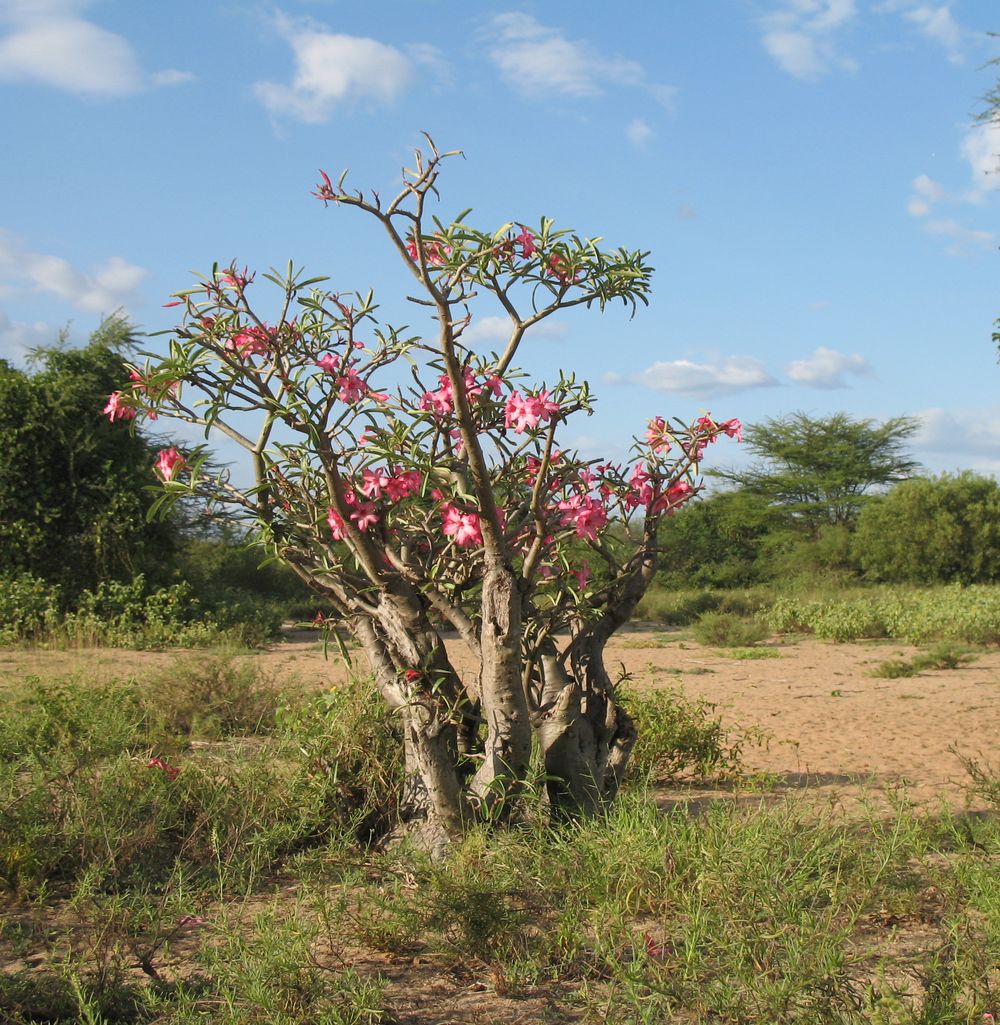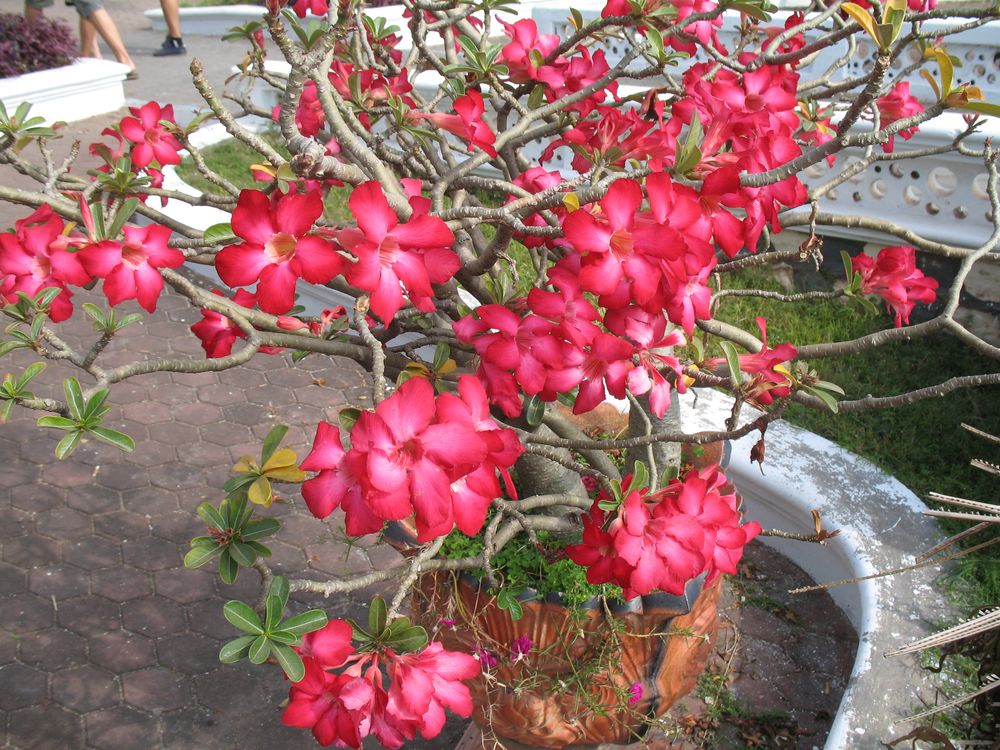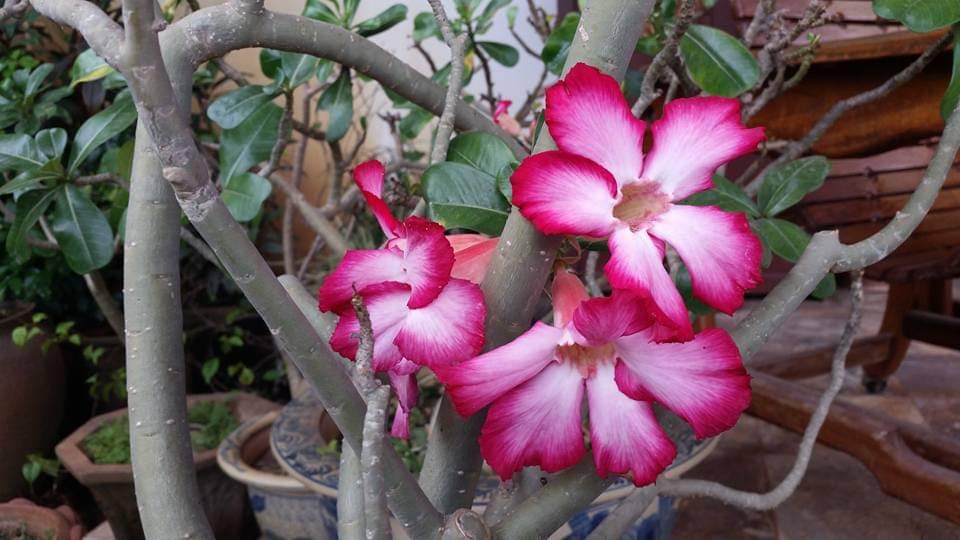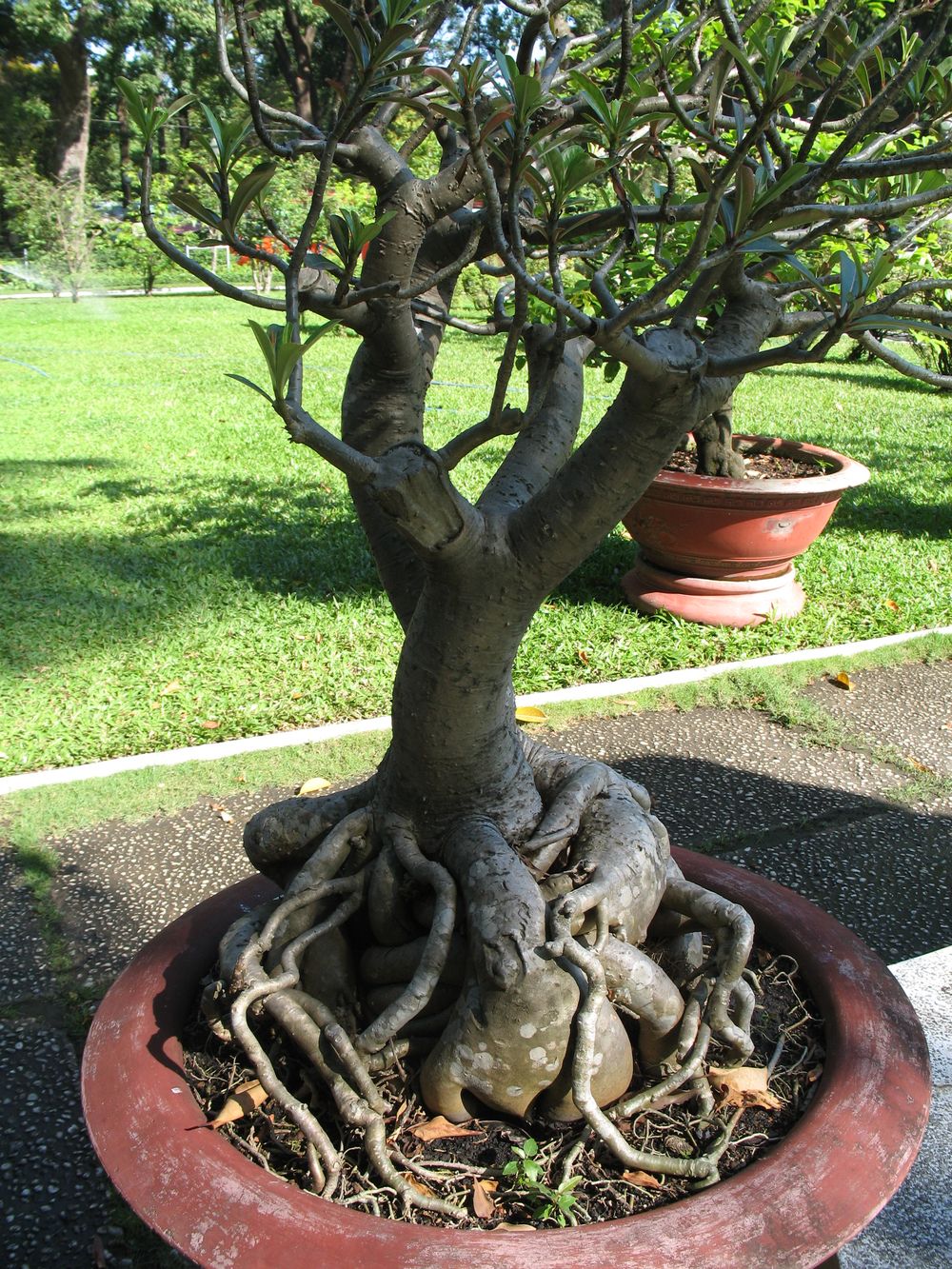The Desert Rose, as its name suggests, is particularly well adapted to hot and dry regions. It is native to the arid regions of Africa and is planted in pots elsewhere.
It is a succulent shrub that can reach 5 meters in hot regions. Its large stems swollen at the base contain abundant and toxic latex. Its thick leaves are arranged in a spiral at the end of the branch. The trumpet-shaped flowers are pink or red, they often appear before the leaves. The fruits are composed of two elongated follicles containing many seeds.
In Laos, where this plant is often potted in gardens, its resemblance to the Frangipani has been noted and it has been named dok champa gnipoun, that is to say “Japanese Frangipani”. Like the Frangipani, it has a symbolic value accentuated by its caudex (swollen root at the base of the trunk) and is very popular in particular for making bonsai.
Latex, which is toxic, is however used to treat abscesses and constipation.
La rose du désert comme son nom l’indique est particulièrement bien adapté aux régions chaudes et sèches. Elle est originaire des régions arides d’Afrique et elle est plantée en pot ailleurs.
C’est un arbuste succulent qui peut atteindre 5 mètres dans les régions chaudes. Ses grosses tiges renflées à la base contiennent un latex abondant et toxique. Ses feuilles épaisses sont disposées en spiral en bout de branche. Les fleurs en trompette sont roses ou rouges, elles apparaissent souvent avant les feuilles. Les fruits sont composés de deux follicules allongés contenant de nombreuses graines.
Au Laos où cette plante est souvent en pot dans les jardins, on a bien remarqué sa ressemblance avec le frangipanier et on l’a nommé dok champa gnipoun c’est-à-dire « frangipanier du Japon’ ». Comme le frangipanier, il a une valeur symbolique accentuée par son caudex (racine gonflée à la base du tronc) et est très apprécié en particulier pour en faire des bonzaïs.
Le latex qui est toxique est cependant employé pour soigner les abcès et la constipation.




The Desert Rose, as its name suggests, is particularly well adapted to hot and dry regions. It is native to the arid regions of Africa and is planted in pots elsewhere.
It is a succulent shrub that can reach 5 meters in hot regions. Its large stems swollen at the base contain abundant and toxic latex. Its thick leaves are arranged in a spiral at the end of the branch. The trumpet-shaped flowers are pink or red, they often appear before the leaves. The fruits are composed of two elongated follicles containing many seeds.
In Laos, where this plant is often potted in gardens, its resemblance to the Frangipani has been noted and it has been named dok champa gnipoun, that is to say “Japanese Frangipani”. Like the Frangipani, it has a symbolic value accentuated by its caudex (swollen root at the base of the trunk) and is very popular in particular for making bonsai.
Latex, which is toxic, is however used to treat abscesses and constipation.
La rose du désert comme son nom l’indique est particulièrement bien adapté aux régions chaudes et sèches. Elle est originaire des régions arides d’Afrique et elle est plantée en pot ailleurs.
C’est un arbuste succulent qui peut atteindre 5 mètres dans les régions chaudes. Ses grosses tiges renflées à la base contiennent un latex abondant et toxique. Ses feuilles épaisses sont disposées en spiral en bout de branche. Les fleurs en trompette sont roses ou rouges, elles apparaissent souvent avant les feuilles. Les fruits sont composés de deux follicules allongés contenant de nombreuses graines.
Au Laos où cette plante est souvent en pot dans les jardins, on a bien remarqué sa ressemblance avec le frangipanier et on l’a nommé dok champa gnipoun c’est-à-dire « frangipanier du Japon’ ». Comme le frangipanier, il a une valeur symbolique accentuée par son caudex (racine gonflée à la base du tronc) et est très apprécié en particulier pour en faire des bonzaïs.
Le latex qui est toxique est cependant employé pour soigner les abcès et la constipation.








The Desert Rose, as its name suggests, is particularly well adapted to hot and dry regions. It is native to the arid regions of Africa and is planted in pots elsewhere.
It is a succulent shrub that can reach 5 meters in hot regions. Its large stems swollen at the base contain abundant and toxic latex. Its thick leaves are arranged in a spiral at the end of the branch. The trumpet-shaped flowers are pink or red, they often appear before the leaves. The fruits are composed of two elongated follicles containing many seeds.
In Laos, where this plant is often potted in gardens, its resemblance to the Frangipani has been noted and it has been named dok champa gnipoun, that is to say “Japanese Frangipani”. Like the Frangipani, it has a symbolic value accentuated by its caudex (swollen root at the base of the trunk) and is very popular in particular for making bonsai.
Latex, which is toxic, is however used to treat abscesses and constipation.
La rose du désert comme son nom l’indique est particulièrement bien adapté aux régions chaudes et sèches. Elle est originaire des régions arides d’Afrique et elle est plantée en pot ailleurs.
C’est un arbuste succulent qui peut atteindre 5 mètres dans les régions chaudes. Ses grosses tiges renflées à la base contiennent un latex abondant et toxique. Ses feuilles épaisses sont disposées en spiral en bout de branche. Les fleurs en trompette sont roses ou rouges, elles apparaissent souvent avant les feuilles. Les fruits sont composés de deux follicules allongés contenant de nombreuses graines.
Au Laos où cette plante est souvent en pot dans les jardins, on a bien remarqué sa ressemblance avec le frangipanier et on l’a nommé dok champa gnipoun c’est-à-dire « frangipanier du Japon’ ». Comme le frangipanier, il a une valeur symbolique accentuée par son caudex (racine gonflée à la base du tronc) et est très apprécié en particulier pour en faire des bonzaïs.
Le latex qui est toxique est cependant employé pour soigner les abcès et la constipation.


